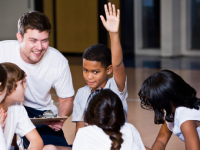PBL Pilot: Navigating Group Work
Fifth grade teachers use their PBL pilot program to teach the leadership and collaboration skills that future employers are likely to expect of their students.
Editor's Note: Matt Weyers and co-author Jen Dole, teachers at Byron Middle School in Byron, Minnesota, present the sixth installment in a year-long series documenting their experience of launching a PBL pilot program.
The National Association of Colleges and Employers (NACE) facilitates a yearly survey that asks employers to identify the skills they value most on the resumes of potential employees. The most recent version of this survey features a tie for first place with 77.8 percent of employers listing "leadership" and "ability to work in a team" as the attributes they most desire. Naturally, we felt like we had to ask ourselves, "If we know we're teaching in a project-based learning format, and if these are the skills that employers say they desire, how do we meaningfully and purposefully incorporate leadership and teamwork or collaboration into our projects?"
After a great deal of research and deliberation, we decided to use two different ideas to facilitate our group work goals. The first is a process similar to one outlined in Turning Student Groups into Effective Teams from the Buck Institute for Education. We are simply calling it the Mediation Process. The second is utilizing specific group roles outlined in Bernabei and Cody’s Top 20 Teachers. Specific details for each of these concepts are as follows.
The Mediation Process
The Mediation Process is a response to age-old group work questions such as:
- How do we as teachers best respond to students who are not actively engaged or participating in the work?
- How do we fairly assess groups when it has become evident that one person has done all (or none) of the work?
We believe one part of the answer is turning the power back over to the students. We've done this by providing them with the autonomy to recognize when they are having group issues, and to ask us to begin a formal mediation process designed to mitigate problematic group dynamics. Mediation means requiring students to have multiple direct, structured conversations with one another. The end goals of the process are:
- Increasing communication
- Learning to develop solutions to their own problems
- Building understanding that all behaviors have an impact on others
To initiate the mediation process, we ask students to contact us via email. The email needs to include a description of the problem they are encountering, as well as an outline of what they would like to see happen. In most cases, they ask to voluntarily remove themselves from a group, or have another group member leave, in which case the removed member can formally apply to join a new group. The four steps of the process include:
- One-to-one (teacher mediated, may happen 2-3 times)
- Team intervention (teacher mediated)
- Team and teacher intervention
- Removal decision
Top 20 Teachers
The book Top 20 Teachers by Paul Bernabei and Tom Cody outlines specific roles with individual responsibilities for students to fulfill. The four roles, rotated on a weekly basis, include:
- Asker: The person who repeats the question
- First: The person who responds first
- Scribe: The person who writes down notes
- Voice: The person who reports out to the whole group
We have found that by assigning roles within a group, each member is valued and contributes regularly. By rotating the roles on a weekly basis, we are providing all students the opportunity to demonstrate the leadership and teamwork skills that employers told the NACE job skills survey they're looking for. These roles have proven useful in many ways.
For example, students who are naturally more inquisitive will approach us with a question without ever having had any dialogue with their group. The roles enable us to immediately ask the questioning student, "Are you the Asker?" If they are not, they need to go back to their group, ask their question of the group, and if no one knows, the student assigned to be the Asker will return to us for further clarification. This has empowered the students to work together and communicate on a deep and consistent basis. In addition, more often than not, the group can answer the majority of their own questions, which has allowed us the freedom to circulate the room with more regularity.
Our Reflections
The combination of the Mediation Process and the roles from Top 20 Teachers has revolutionized our approach to group work. Overall, we have found both these ideas to be wildly successful. Students have repeatedly volunteered to us that they enjoy having a voice in deciding how to best maintain group function, as well as having a set of defined responsibilities on a day-to-day basis. As teachers, we enjoy these processes as they require us to be very involved in the lives of our students, as well as explicitly model for them how effective communication can overcome significant hurdles in group work. Having said that, we are constantly wary that we cannot place too much responsibility on the shoulders of our ten year-olds when it comes to managing group dynamics. We are especially cognizant of the dynamics involved with a "removal decision," which we know needs to be saved as a last resort.
As educators, do you have any successful group work strategies that you would like to share? If so, we would love to read them in the comments section of this post.
